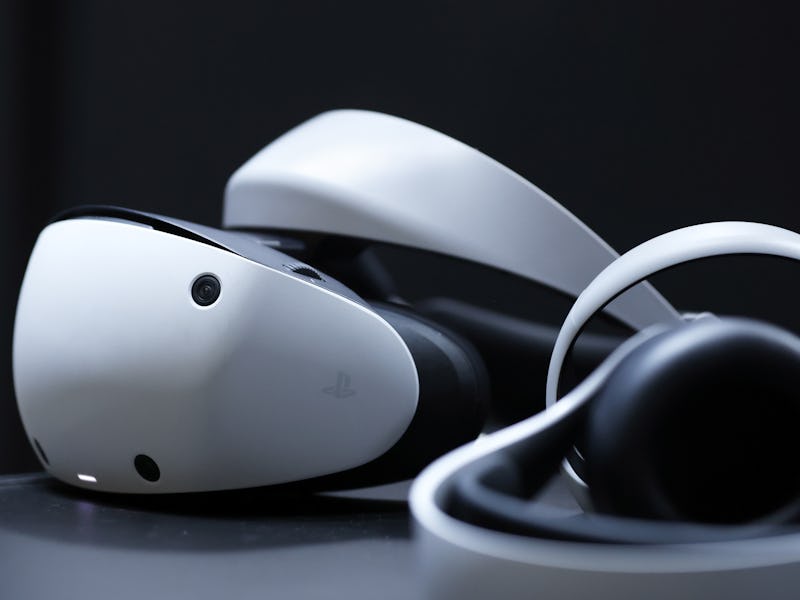A Fix For PlayStation VR 2’s Biggest Problem Is Closer Than You Think
A PC adapter could be the key to revitalizing the impressive piece of hardware.

Sony is releasing an adapter that will allow the PlayStation VR 2 to work on PCs, and it could solve a major issue plaguing this underwhelming piece of hardware.
According to a South Korean National Radio Research Agency filing, a PS VR2 adapter was submitted for certification and approved in March. While there is no detail of how this device will work or how much it will cost, the name makes its purpose crystal clear. The listing also aligns with Sony’s announcement in February that they were testing PC compatibility for their suped-up headset.
The listing signals Sony’s latest effort to open up their traditionally closed platform to more players regardless of their hardware of choice. They’ve released their first-party games on PC to great success and are currently hiring engineers to bring experiences to mobile. With Sony’s support for its VR headset being as lackluster as it’s been, allowing PC users to take advantage of the remarkable piece of tech seems like a merciful move for the floundering device.
The PlayStation VR 2 is one of the best VR headsets on the market. But the price point and lack of games has made it tough to recommend.
Released in February 2023, the PS VR2 was a hopeful start to PlayStation’s plans for the VR market. While the first PlayStation VR (released in 2016) was a functional entry point for the virtual reality format, its lack of resolution, limiting controllers, and general clunkiness made it a relic in just a few years. The second iteration of the headset corrected all of these issues with more processing power and better resolution, better hand tracking and controllers, a more comfortable headset design, and crucial reducing the setup to a single cable that plugs into the PlayStation 5.
As critic reviews widely stated, the PS VR 2 corrected nearly all of the technical hurdles of the original and in some ways surpassed other popular virtual reality devices. Unfortunately, PlayStation couldn’t keep the momentum of its impressive hardware going, thanks to a lack of developer support, its premium price tag, and the evolving competition.
Unlike its predecessor, PS VR2 launched into a very different landscape for virtual reality. In 2016, top-of-the-line VR gaming meant plopping down four figures on a powerful PC, then hundreds of dollars on a decent headset. Spending $400 on a PS VR, and $400 on a PS4 was a steal for those passionate enough about this exciting new frontier for games.
The original PlayStation VR was no where near as powerful as its successor, but it was one of the few afforable ways into virtual reality gaming at the time.
Eight years later, PlayStation’s VR offering is one of the most expensive ways to get into VR gaming. It’s hard to recommend spending more than a thousand dollars on a PlayStation 5 and a wired headset when companies like Meta are selling a completely wireless and perfectly capable headset for half the price.
Even if you buy into PS VR2, there’s not a whole lot there to keep you playing. While it launched with a decent amount of games, there’s been a palpable drop-off since. Most of its recent releases have been ports of games that can be played elsewhere. Developers told Inverse in December that developing for the device incurs challenges thanks to compatibility issues with popular game creation tools like Unity and the very closed-off nature of making games for an established console manufacturer.
Nearly all of PS VR2’s issues can be solved with the ability to use the headset on a PC. Access to the vast library of VR experiences on Steam would bolster what’s available to play. Getting rid of the PlayStation 5 requirement allows the PS VR2 to be competitive with other headsets for the first time, which may improve its lagging sales. More units sold in-turn makes it easier for developers to justify developing newer games for it.
Like Sony’s push into mobile and Steam, a PC adapter for the PS VR2 could only mean great things in the long term. Whatever Sony’s cooking up for the future of VR, we’ll find out more during Thursday’s State Of Play stream. Sony says that among the 14 announcements scheduled for the show, new developments for the PS VR2 will be among them. The imminent release of the adaptor could be good for those who have already invested heavily in PS VR2 and are still waiting for updates with bated breath.